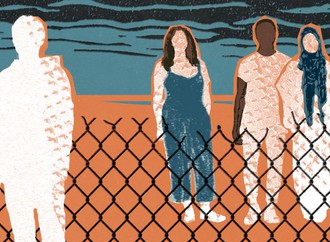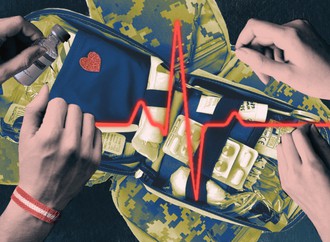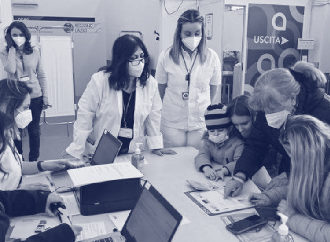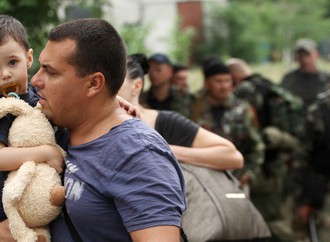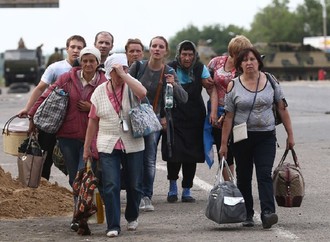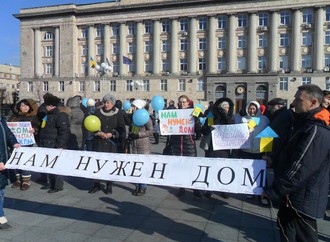One of the urgent issues for the post-war reconstruction of Ukraine is the future of internally displaced persons. Due to the Russian annexation of Crimea and the war in Donbas, in 2014-2021 about two million Ukrainians were forced to leave their homes and move to other places within Ukraine. After the full-scale Russian invasion on February 24, 2022, 8 million more became displaced. Currently, some IDPs have moved in with relatives or are renting housing on their own in safer cities, but a lot of them are temporarily living in municipal buildings or in "modular towns". Many displaced people struggle to meet basic needs and to access the necessary infrastructure.
International donors and organizations have traditionally played an active role in solving the problems of internally displaced persons, both before the start of the full-scale invasion and now. This role is not new for them – they have been involved in similar activities in many parts of the world for decades. However, how effective is the humanitarian intervention of international organizations and donors? Are modular towns and hastily erected camps a good solution to the housing problem, and why do international organizations and even governments of some countries prefer to build such settlements? What are the disadvantages of project solutions in the context of forced displacement of a large number of people? What are the structural problems of international organizations` established approaches? These questions are answered by the anthropologist Elizabeth Dunn, who studied life in IDP camps in Georgia (No path home: humanitarian camps and the grief of displacement. Cornell University Press, 2018).
We did this interview before the full-scale Russian invasion began. However, unfortunately, it has not lost its relevance;, on the contrary, the interview allows us to take a critical look at important problems and dubious decisions that Ukrainian society will have to live with for years, if not decades.
How did you get interested in this topic, why did you decide to go to Georgia to do this research and camps for displaced people?
I had gone there originally with the US Center for Disease Control who were working on a big project on botulism because they needed somebody who knew both post socialism and canning. I got to go to Georgia several times during the period of state collapse before the Rose Revolution and in 2008 I had gotten a Fulbright to go work in Georgia. I had come to Bloomington [Indiana, USA] to learn Georgian because it's the only place in the country where you can do this. And I was leaving Bloomington after eight weeks of intensive Georgian, and I had rented out my house, and I had sold my car and I had a five-year-old and a lot of suitcases. We were headed for O’Hare airport when the phone rang and it was the US Department of State saying “Where are you?” and I said “I'm in the car headed for O’Hare”. And they said “Don't get on the plane, the Russians have bombed the airport”. That was my sort of introduction to this world.

Georgian refugees from South Ossetia in a refugee camp in Rustavi (20 km from Tbilisi), August 20, 2008
I had been going to Georgia to work on a food related project, since a lot of my work is about food studies, but all the farmers I was planning on working with had been ethnically cleansed from South Osetia - they were ethnic Georgians. So I went to see what was going on in the camps, and then I got swept into this entire world of humanitarian aid. With no preparation for it pretty much like everybody else, like all of the IDP are themselves, none of us really understood what was happening. And at that point, there was not a lot of literature on humanitarianism in anthropology or a critique of humanitarianism. So I wrote this book backwards, like first I got there, then I found the problem, and then I did the field work and, finally, I read the literature. So it was certainly an interesting project to do, and of course all done in the temporality of emergency.
You say that at that time there was not that much literature on humanitarianism, so it seems like it's a very recent development in anthropology and in social sciences more generally. That nowadays, even in your book with the other work that you are discussing it seems like a very vibrant and a very dynamic field, so why do you think this is an upsurge in interest in this field, in the last decade or 15-20 years?
First of all, it is responding clearly to events, so the number of displaced people around the world has gone up dramatically from about 9 million in 1988 to today over 80 million people. And then, because of climate change, disasters are happening more and more often, it is now a sort of usual thing to have an emergency. So, certainly, we are all living with disasters more frequently and we all are thinking about how to plan for those disasters and what the responses are, and so the practitioner community is also very interested in.
Therefore I'm working right now with the Indiana Red Cross and they're realizing that their model, which is the typical humanitarian model which is to truck in stuff. Emergency hygiene kits and diapers and beds and blankets. That model is no longer sustainable in an era of widespread disaster. They can't do it anymore logistically and it's not actually going to stave off the effects of disaster and so they're looking for another model. I think we're responding very much to a change in the world, not necessarily just a change in our own theories.
And one thing that I found very interesting in your book: how this humanitarian kind of non-state agents are actually taking over some of the roles of the state when the states are seen as failing or not able to protect their own citizens. As you mentioned this division of the world into countries that are able to take care of their citizens in countries that are not able to, so kind of legitimizes this intervention of International humanitarian organizations with quite strong agency, even imposing on the governments a certain vision. What could you say about this political dimension, what changes in this configuration of power between the state and non-state agents do you see?
We've been seeing for two decades now the outsourcing of state functions to private agencies, and this is done in the United States with contracts to USAID then subcontracting to private firms like Chemonics or to supposedly not for profit, NGOs, like Care International. And what happens is that these agencies which appear to be independent, because they are working on contract to the State become de facto agents of the state.
In states that seem to be weak and capacity building, basically means that the NGO comes in and tells a government agency how it should run and dictates policy to it. NGOs in fact become qualified States and they come to have more authority than states.

Georgian refugees from South Ossetia in a refugee camp in Rustavi (20 km from Tbilisi), August 20, 2008
In the Ukrainian context where the war has been going on for eight years, we also have a situation where the humanitarians came in and offered emergency relief like clothing and food and hygiene items. And now they're saying, well, we can't keep doing this for years and years and we need to think of something else. But what they're proposing instead, like all this “capacity building”, “resilience”, “community development”, “empowerment”, different seminars for entrepreneurs.
We see that alternatives sometimes are also not really helping. Many people say: “Oh, we wish they had just continued giving us humanitarian aid, we don't really need those seminars and workshops”. At least this emergency relief was something tangible. Maybe you can elaborate a bit on this idea and how NGOs work in situations of prolonged conflict and these half-frozen conflicts.
I start out with that certainly NGOs have not been prepared to work in what used to be the second world. Countries that have architecture and infrastructure left over from the socialist period. Those were in fact developed economies, although they were not necessarily capitalist economies. In the book I tell the story of a grant proposal I saw in which they just took out the word Congo and put in the word Georgia but forgot to take out the word Congolese and substitute for Georgian to it. One of the things that ended up being provided in Georgia was breastfeeding assistance, which makes a lot of sense in Congo, where the water is dirty and formula is in short supply and kids can die of diarrhea. But it doesn't make sense in Georgia, which had clean municipal water throughout the conflict, and where breastfeeding is widely practiced. It was the wrong project for the wrong context. Third World solutions get imported to the so called second World places where they don't fit the context very well.
But a bigger problem is that there are two temporalities at work here: the acute and chronic. It is known how to help victims of an earthquake who just need a bed and a blanket until people can figure out what to do. What they don't know how to deal with is people who are going to be in a camp for a long time, what happens when you have a sort of artificially created community and how you're going to manage that, from the beginning, knowing that the likelihood is that they will be there 30 years.
And one of the things is how this plays out structurally. For example in the camps, I worked in, they built cinder block houses, knowing that this was going to be a situation that was going to last longer than tents could provide for. So they built these little cinder block houses, but what they didn't do was dig sewage lines first so there was no sewage in many of these places. Considering the chronic temporality instead of temporal from the beginning would be a real change for some of these agencies.
And, interestingly, the people thinking most about the temporality of the chronic are displaced people themselves, and many of them are acutely aware that entering into a camp is a trap. You know they don't give you enough to stay alive, you end up spending down whatever resources you still have and then you're broke and can't leave the camp and you're stuck there. There's no work, there's no way to earn extra money, you're never getting out. So many people are rejecting that, from the beginning. For example, a large camp was built in the Jordanian desert, it was built for nearly 100,000 people and last I heard, there were only 14,000 people in it, because it's in the middle of the Jordanian desert there's no employment.
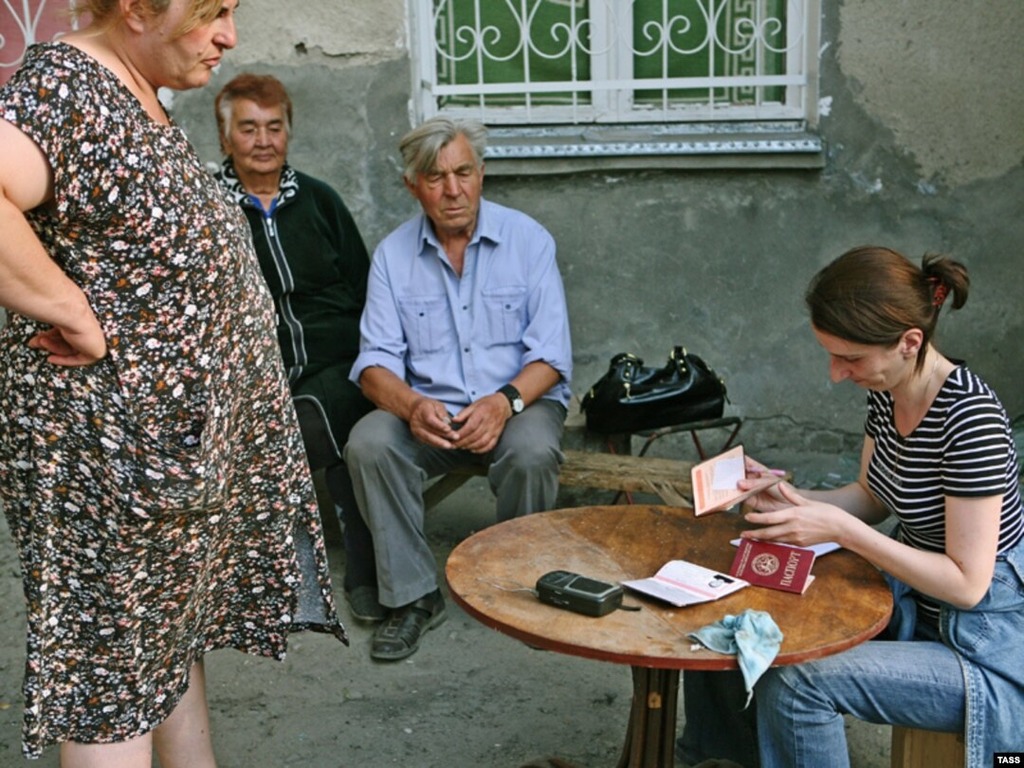
Information gathering in South Ossetia, August 20, 2008
I know it's a very common strategy in many countries that you would have these standalone camps in the middle of nowhere for IDPs but in the Ukrainian case actually most IDPs went to places where they had friends or family in different cities, and then they would be asking for assistance there. The Ukrainian Government seems to have taken a different strategy from the Georgian. I wonder why the Georgian government decided it was a good idea in the first place to have these camps.
It's important to understand that camps are never for refugees, camps are built for the convenience of states and agencies. And camps make it very easy to distribute goods if you're an agency, because you just have to drive a truck one central place and unload and distribute rather than tracking people down in the city. And for states they offer a number of advantages and one of them is to keep people permanently mobile, so that if you ever can retake the territory, you can move people in very quickly. I think that the Georgian Government in the first instance, wanted to think about retaking that territory [Trapped North Ossetia by Russia in 2008]. Which is not going to happen anytime soon.
But the other issue is that there aren't very many places Georgians could have gone, they would have ended up in Tbilisi. The government had learned an important lesson from an earlier wave of displacement in the mid 90s, when ethnic Georgians had to flee the breakaway province of Abkhazia. Those Georgians from Abkhazia ended up occupying military bases and sanatoriums and old hotels. And that was an experience that the Saakashvili government did not want to repeat. It believed that a giant influx of thousands of people into the capital would strain Labor markets, would put a strain on housing prices and would make it very difficult to provide services.
And this is 2008 I'm talking about, those people were still occupying the hotels and libraries and sanatorium that they were first put into in 1993. For the government was a serious problem, the lingering presence of IDPs in the capital. So they pushed hard to build these camps and pushed IDP into these camps as quickly as possible. That was for the convenience of the state, not for the convenience of the IDP.
In Ukraine, we also have some ‘temporary mobile villages’ or settlements, but they're usually in towns and people would get jobs in the cities. There was some research done on these settlements by one of the NGOs in 2018 or 2019, where they also showed that three or four years from the start of the war and people were still there. It's now past that guarantee period for those houses and there's many structural problems, but 38% of the people were saying that they see no prospects of moving anywhere and 27% said that the only prospect they can envisage is returning home. So there are some similarities as well, although in Ukraine, they look more like some settlements on the outskirts of cities and people are more integrated into local communities.
Another difference is that Ukraine doesn't have a primate city capital, which is disproportionately large and Georgia de facto only has one major city.
And also that many IDP didn't go to the key cities but stayed in the nearby towns not not very far from the demarcation line. Although it also allows the government not to address the problem for quite a long time by saying that it's kind of a local problem there and leaving it to the humanitarians.
One other thing is this economic side of humanitarian aid, where you say that it's actually a very big industry, growing from 1 billion in 1991 to up to $25 billion. And you also mentioned this disaster capitalism as a whole, a market that is quite lucrative.
Tell more about this political economy of humanitarianism and why it is so lucrative economically and so profitable and could it be just one of the ways also to channel the surplus value for capital.
One of the things that we have always assumed in the study of humanitarian aid is that refugees or displaced people are somehow outside capitalism, because aid agencies are outside capitalism. And that's so not true. One of the things you have to look at is how these agencies themselves operate - they do not see their clients as displaced people. Their clients are the donors and their object is to produce value for their customer - the donor. They do so, usually in the form of reports and reporting on the effects of aid.
I joked that I've never seen an evaluation that said that the project was a failure, you just rarely see that. Every project is a stunning success, every project serves a lot of people, every project was a tremendous amount of help. And yet a year later, they get funding to do the same project over again, as if the first one never happened.
You have to think about the customer, being the donor. And the unit of value is the report rather than actual humanitarian aid to displaced people. This gives aid agencies a massive incentive to keep all the cash they can enhance so the whole system is built on subcontracting. For example there is an emergency, the US Congress allocates money for foreign aid, so that money gets sent to USAID. USAID then subcontracts to an international NGO like Care International. Care International then subcontracts to a local NGO and the local NGO is the actual service provider. Everyone here takes overhead somewhere between 20 and 50%.
The money that passes through gets skimmed off, and so what we find is that in the end it is 17 cents on the dollar that actually flows to the beneficiaries of aid. Their incentive is to keep as much money as they can in house and so these endless training seminars are one way to do that. You ostensibly provide something of value to displaced people, but in fact not a cent passes through.
Everybody else takes a salary, the refugees are always assumed to work for free and they're getting stuff that they themselves find very little value. Over time, as the situation goes on and on, people will start to refuse to waste their time.
When you talk to agencies, they very often will talk to you in the language of business. They use a lot of the tech management techniques, the metrics, the forms of evaluation that are used in for profit businesses. The reason is that they think of themselves and they operate as if they were a for profit business.
Many of the Peace-building training and initiatives in Ukraine somehow assume that IDPs don't know how to be good citizens or how to be peaceful or, for example, not to commit domestic violence, so we need to teach them. Whereas, for example in the Ukrainian context there's no evidence that the situation with those issues is worse in those areas than it is in other parts of the country. And, in fact, if we look at surveys like tolerance of people who are different, who speak a different language or who are of a different ethnicity, these communities by the demarcation line are actually among the most tolerant because they know what war is and they want to avoid conflict. But somehow all these projects are situated in those communities so there's also these assumptions about these people somehow being different and less civilized than the other Ukrainians. It is like transferring responsibility for the war on those people, as if it was their fault.
It's very much a problem of scale. Aid agencies cannot acknowledge that these conflicts are geopolitical in origin. So they have to make them local because NGOs can only operate at the local scale, they have no influence at the national or at the international scale. So they transform problems at a higher scale into micro scale problems that they can then address.
And you also see very often that these problems of large scale even get made even more micro. An NGO cannot operate on Vladimir Putin, but what they can do is assume that violence is happening at the household level, as if fixing that problem will fix the larger macro political problem (and it will not).
I'm always amazed that displaced people are very often treated as if they are victims of natural disaster. We cannot talk about or address the political issues that caused the displacement. This is a problem of politics, we need to talk about the politics that displaced people and the politics that will resolve their situation, not just band aid solutions at the micro level.
And I think one of the interesting things is that the aid workers themselves certainly deeply understand the limits of what they're doing. There was a great blog called “shit aid workers” and it was so satirical and very cynical about things like for simulation, which is a portmanteau of facilitation and manipulation in which you have a big meeting and guide people to the solution, you have already decided on. Aid workers and their bosses are acutely aware of these problems, but there are a couple of issues that make it very hard to change gears.
One is that the language of the aid world tends to lock you into a particular way of thinking in which what NGOs can do is the only solution to the problem. If you are an NGO leader who wants to get more grants to continue doing more work, what you can't say is - this problem is beyond us, this is a macro political problem, this is a problem of governments, so you guys solve it. They have to believe that what they're doing is helping because if it's not then all the work they're doing is in vain. And so they're locked into the idea of the project and the project as a unit of action. And a project is a small scale endeavor that is limited in time that is funded for a short period and then disappears.
Changing the notion of the project to one in which you're providing ongoing support for long periods of time is such a political bombshell that is politically unsustainable in the donor community. And they will fund project after project after project, knowing that they can only get money from a single budgetary cycle and they have to propose a project within that budgetary cycle. So changing the time span of humanitarian aid means changing the financial infrastructure of humanitarian aid, which means changing the way that budgeting happens at the State level, and that is very difficult to do.
The other thing is that the way that agencies measure their intervention really changes the way they act so they need a concrete visible tangible measurement of their impact and sometimes they can skirt around this by just talking about the number of participants, you know we provided a seminar to 300 people, therefore, we help 300 people.
But a lot of times they need something like the number of things distributed and the number of things installed. Until you can move agencies away from these tangible short term metrics of performance evaluation you're not going to operate.
What do you think must happen for these organizations to rethink and change something? Or maybe you already see some projects that are operating differently or some kind of positive examples of how things can be done differently?
I think the system of subcontracting is clearly not working at all. That's common knowledge now in a way, it was not in 2008 when I wrote this book. I think money has been increasingly diverted away from subcontracted projects and towards other kinds of solutions so that is good news. But agencies themselves have to change what they think they do.
I'm circling back to this work I'm doing with the Red Cross. The Red Cross, for many years has been a logistics company, that is their expertise. They are super good at loading up stuff from a warehouse moving it into a disaster zone having a process for distributing. Why not leave it to Walmart, if they already have the infrastructure for it? The Red Cross itself is starting to wonder if it's not a logistics company, what is their role in preparing for disaster? They are now starting to see themselves as a Community Development Agency - that their job is to facilitate interpersonal ties in communities where people are highly individualized and don't know each other. Basically they are building Community organizations and community relations to make communities more resilient in disaster that is preparing people to help themselves without outside help.
We can talk about how neoliberal that is which it is. But it's also actually fairly pragmatic, knowing that the likelihood of a State Agency like FEM (Federal Emergency Management program the United States) can come in and help in any meaningful way in a short period of time is very low. So these communities should prepare to be on their own.
Despite all that criticism you're also very active in these projects. Many times all these aid workers who obviously see many of the problems, but yet they still are committed to do these projects and to helping people. What keeps you going or what keeps these other people going while they're aware of all these systemic problems?
Since returning from Georgia I have been on the board of a resettlement agency. I run a small NGO here in Bloomington aimed at helping asylum seekers, evacuees, refugees. And I do a lot of personal stuff - I drive people to the eye doctor and I have an Afghan friend I'm teaching to drive.
One of the things that drives me crazy about anthropologists is they have this idea that if they just maintain clean hands, then they maintain their moral purity. And so they can stand on the outside and complain and criticize because they never have to deal with the moral complexity of action. It's really easy to criticize from the outside and it's really hard to figure out a solution from the inside and anthropologists do not see themselves as solution providers, they are critics. I think that is one of the things you learn as an anthropologist. Working in humanitarian aid is about the moral trade offs you have to make, and let me tell you in humanitarian aid there is no morally pure action. Everything you do has moral complexity to it and you're constantly navigating.
The moral complexity of what you do, including knowing that sometimes what you're doing is harming more than helping because you yourself are trapped in a bureaucratic structure that demands that. But I am so good at dealing with large bureaucracies and getting around the rules, which is a skill I learned in Poland, that very often what i'm doing - I'm trying to navigate the bureaucracy for my clients in a way that mitigates the harm that bureaucracy does to them.
For Ukraine, what are the things we should not do, or that we should avoid so maybe learning from mistakes in other places.
The most important thing to do is to assume that this will be forever. If you have displaced people, you should assume that they are going to be displaced for the rest of their lives. So you might focus on resettlement rather than on temporary humanitarian aid. What aid agencies can do is to help build the infrastructure for resettlement. Building apartment buildings, working on job placement, to help people rebuild fully functioning lives as competent adults. Rather than infantilizing them and making them dependent on aid. They aren't forced to move into the European Union, where they're going to be super stigmatized, where they're going to be economically adrift, where it's going to be incredibly difficult for them to permanently resettle. It's just so much better to plan on any kind of displacement being permanent within Ukraine.

